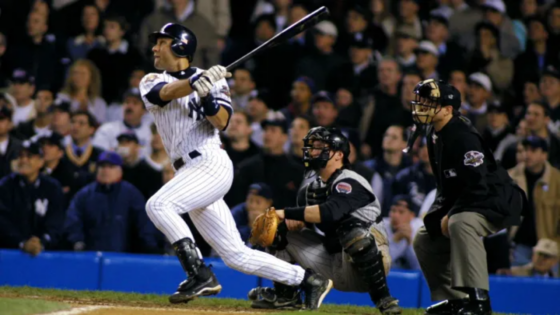Some baseballs are scuffed. Others are sacred. And then there’s the one that sat quietly in a Connecticut closet while Wall Street headlines and Bronx cheers came and went. Call it fate, nostalgia, or just New York drama with a perfect seam—whatever it was, Derek Jeter and the New York Yankees delivered a moment so cinematic, it left one man clutching history and the rest of us clutching tissues.
Some baseball games are historic, and some are emotional, but a game can rarely have both such emotions. And one such moment came from a long-time Yankees fan, Neil Dunleavy, who has become a part of history after announcing that he is going to auction the ball that made Jeter, Mr. November, and eased the pains of millions.
In an article written by Jeff Passan, he talked about what the fans felt while auctioning off the ball, which is a part of American history. Dunleavy said, “I’m selling the ball. I’m not selling the story… I owe this moment a lot. I have always been able to make everybody smile when I tell this story.” In addition, Passan emphasizes the importance of Homer. Passan wrote, “The time around Sept. 11 was devastating, and baseball offered something around which the country could coalesce… The Yankees represented the strength of New York and the game’s meaning to the city and country.”
It’s the tale of a crisp autumn night in 2001, New York City was still healing from the pain of September 11th. The nation was searching for hope, and Yankee Stadium became a place where people could come together and remember what it felt like to cheer again. That night, as the clock neared midnight, Jeter stepped up to the plate in Game 4 of the World Series. With two outs in the 10th inning, he swung and sent a baseball soaring over the right-field fence—a moment that would earn him the nickname “Mr. November” and give fans a reason to smile when they needed it most.
“I’m selling the ball. I’m not selling the story.”
24 years ago, Derek Jeter became Mr. November. The story of what happened to the ball never has been told. Free at ESPN: Why the relic from perhaps the Captain’s most famous moment is now up for auction. https://t.co/3BOXtFNSCN
— Jeff Passan (@JeffPassan) June 6, 2025
For nearly twenty-five years, the ball from that unforgettable home run sat untouched in a closet, quietly holding the memories of a city and a country finding comfort in baseball. For Neil Dunleavy, the fan who caught it, the ball became more than memorabilia. It was a story, a time capsule, a scar sealed in cowhide. He didn’t just hold history—he held healing. And for millions, that World Series became a symbol of resilience wrapped in pinstripes.
Now, nearly a quarter-century later, the ball is up for auction, fetching over $100,000. But Dunleavy isn’t just cashing out—he’s giving back. A portion of the proceeds will go to Jeter’s Turn 2 Foundation. Because some souvenirs gather dust, but this one still spreads hope.
In a world where memorabilia often means profit, Dunleavy chose purpose over price tag. The ball may be leaving his hands, but its impact isn’t leaving the city’s heart. Some chase signatures; others chase meaning. And in a rare twist of sports, sentiment, and sacred timing, this one did both. Turns out, even in baseball, the real value isn’t in the ball—it’s in the bounce back.
Derek Jeter has given us some iconic moments, but how did he make it possible?
When you think of clutch plays and legendary moments in baseball, some names instantly come to mind—Jeter and the Yankees, of course. But greatness isn’t just luck or flashy highlights; it’s the quiet grind behind the scenes, the choices nobody sees, and yes, sometimes saying no to a fishing trip. Let’s unpack how Jeter actually made magic happen beyond the spotlight.
Jeter’s journey to greatness began with small, tough decisions early in life. Choosing practice over a fishing trip, he learned the power of intentional choices. By setting incremental goals like making the Little League All-Star team, Jeter built a solid foundation for success. These small wins shaped his path to becoming a five-time World Series champion.
His grit and mentality defined countless iconic moments, like the “Flip Play” and clutch World Series hits. Jeter believed true character shows when no one is watching, holding himself accountable daily. This mindset turned him into a leader who thrived under pressure and inspired teammates. Even today, the Yankees honor Derek Jeter’s principles with strict team rules on professionalism and preparation. Players still write down goals and commit to constant improvement, as Jeter taught. His legacy lives in the dugout’s culture, where intentional decisions and accountability rule.
If you think greatness just falls from the sky, think again—it’s earned in moments nobody notices. The Yankees still play by Jeter’s rulebook, proving that talent alone won’t win championships—stubborn work ethic and choices do. So next time you marvel at a clutch play, remember: someone said no to fishing.
The post Derek Jeter’s Untouched $110,000 Memorabilia That Helped Ease America’s 9/11 Pain Becomes Public appeared first on EssentiallySports.
